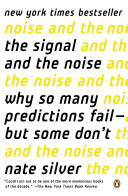Bayes' Theorem Means Scientific Consensus Should Converge
One property of Bayes’s theorem, in fact, is that our beliefs should converge toward one another—and toward the truth—as we are presented with more evidence over time. In figure 8-8, I’ve worked out an example wherein three investors are trying to determine whether they are in a bull market or a bear market. They start out with very different beliefs about this—one of them is optimistic, and believes there’s a 90 percent chance of a bull market from the outset, while another one is bearish and says there’s just a 10 percent chance. Every time the market goes up, the investors become a little more bullish relative to their prior, while every time it goes down the reverse occurs. However, I set the simulation up such that, although the fluctuations are random on a day-to-day basis, the market increases 60 percent of the time over the long run. Although it is a bumpy road, eventually all the investors correctly determine that they are in a bull market with almost (although not exactly, of course) 100 percent certainty.
In theory, science should work this way. The notion of scientific consensus is tricky, but the idea is that the opinion of the scientific community converges toward the truth as ideas are debated and new evidence is uncovered. Just as in the stock market, the steps are not always forward or smooth. The scientific community is often too conservative about adapting its paradigms to new evidence,64 although there have certainly also been times when it was too quick to jump on the bandwagon. Still, provided that everyone is on the Bayesian train,* even incorrect beliefs and quite wrong priors are revised toward the truth in the end.
Notes:
As more and more tests are carried out, scientific opinions should converge around the truth.
Folksonomies: scientific method empiricism truth
Taxonomies:
/finance/investing/stocks (0.612925)
/science (0.395771)
/science/mathematics/statistics (0.158603)
Keywords:
bull market (0.928520 (negative:-0.372956)), Theorem Means Scientific (0.789116 (positive:0.491715)), percent chance (0.772028 (negative:-0.530322)), scientific consensus (0.746583 (positive:0.271937)), scientific community (0.652935 (positive:0.439584)), Consensus Should Converge (0.607109 (positive:0.491715)), Bayes’s theorem (0.549576 (neutral:0.000000)), percent certainty (0.537211 (positive:0.285679)), scientific opinions (0.459613 (positive:0.480516)), bumpy road (0.448037 (negative:-0.631876)), wrong priors (0.438683 (neutral:0.000000)), reverse occurs (0.437840 (negative:-0.478959)), bear market (0.435591 (negative:-0.324819)), day-to-day basis (0.432565 (negative:-0.279057)), different beliefs (0.422164 (positive:0.359085)), long run (0.421919 (negative:-0.357315)), Bayesian train (0.409094 (neutral:0.000000)), incorrect beliefs (0.405990 (neutral:0.000000)), stock market (0.399820 (neutral:0.000000)), new evidence (0.389504 (neutral:0.000000)), time (0.345221 (negative:-0.213985)), investors (0.328653 (negative:-0.397999)), truth (0.325193 (positive:0.480516))
Entities:
stock market:FieldTerminology (0.880678 (neutral:0.000000)), Bayes:Person (0.731660 (neutral:0.000000)), 100 percent:Quantity (0.731660 (neutral:0.000000)), 10 percent:Quantity (0.731660 (neutral:0.000000)), 60 percent:Quantity (0.731660 (neutral:0.000000)), 90 percent:Quantity (0.731660 (neutral:0.000000))
Concepts:
Scientific method (0.957508): dbpedia | freebase
Truth (0.948589): dbpedia | freebase
Investment (0.934322): dbpedia | freebase | opencyc
Epistemology (0.924644): dbpedia | freebase | opencyc
Bayesian probability (0.924578): dbpedia | freebase
Prior probability (0.911796): dbpedia | freebase
Bayes' theorem (0.886652): dbpedia | freebase | opencyc | yago
Belief (0.879489): dbpedia | freebase





